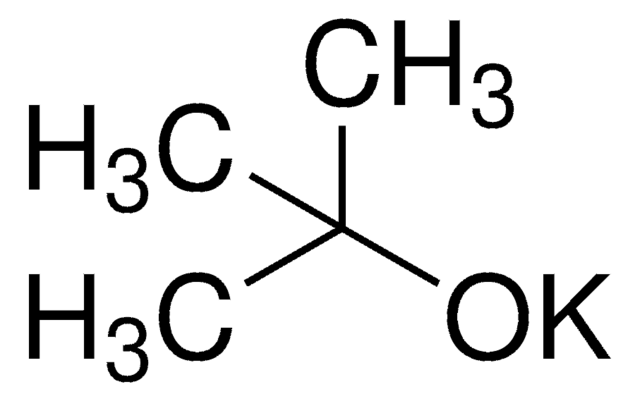8.04918
Potassium tert-butylate
for synthesis
Synonym(s):
Potassium tert-butylate
About This Item
Recommended Products
vapor pressure
0.02 hPa ( 20 °C)
Quality Level
Assay
≥98.0% (acidimetric)
form
powder
autoignition temp.
483 °C
pH
13 (20 °C, 5 g/L in H2O, Hydrolysis)
mp
256-258 °C
density
1.19 g/cm3 at 20 °C
bulk density
500 kg/m3
storage temp.
2-30°C
InChI
1S/C4H9O.K/c1-4(2,3)5;/h1-3H3;/q-1;+1
InChI key
LPNYRYFBWFDTMA-UHFFFAOYSA-N
General description
Application
Analysis Note
Free KOH: ≤ 1 %(m)
Identity (IR): conforms
Signal Word
Danger
Hazard Statements
Precautionary Statements
Hazard Classifications
Eye Dam. 1 - Flam. Sol. 1 - Self-heat. 2 - Skin Corr. 1A - Water-react 1
Supplementary Hazards
Storage Class Code
4.2 - Pyrophoric and self-heating hazardous materials
WGK
WGK 1
Flash Point(F)
Not applicable
Flash Point(C)
Not applicable
Certificates of Analysis (COA)
Search for Certificates of Analysis (COA) by entering the products Lot/Batch Number. Lot and Batch Numbers can be found on a product’s label following the words ‘Lot’ or ‘Batch’.
Already Own This Product?
Find documentation for the products that you have recently purchased in the Document Library.
Customers Also Viewed
Our team of scientists has experience in all areas of research including Life Science, Material Science, Chemical Synthesis, Chromatography, Analytical and many others.
Contact Technical Service















